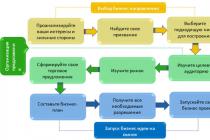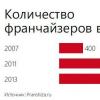Introduction
The purpose of the workshop on the organization of production is to expand and deepen theoretical knowledge, instill the necessary skills to solve the most common tasks in practice on the organization and planning of production.
The workshop includes tasks for the main sections of the course. At the beginning of each topic, brief methodological instructions and theoretical information are presented, typical tasks with solutions and tasks for independent solution.
Availability in each topic guidelines and brief theoretical information allows you to use this workshop for distance learning.
Calculation of the duration of the production cycle
As a measure of performance production process serves as the duration of the production cycle.
Production cycle- the period of stay of objects of labor in the production process from the moment the raw materials are launched to the moment the finished product is released.
The production cycle consists of working time, during which labor is expended, and break times. Breaks, depending on the reasons that caused them, can be divided into:
1) on natural or technological - they are due to the nature of the product;
2) organizational(breaks between shifts).
The duration of the production cycle consists of the following components:
T cycle = t those + t eat + t tr + t k.k. + t m.o. + t m.c.
Where t those– time of technological operations;
t eat - time of natural processes (drying, cooling, etc.);
t tr - the time of transportation of objects of labor;
t c.c. - quality control time;
t m.o - interoperative waiting time;
t m.c. - time spent in intershop warehouses;
(t three t k.k. can be combined with t m.o).
The calculation of the duration of the production cycle depends on the type of production. IN mass production the duration of the production cycle is determined by the time spent by the product on the stream, i.e.
T cycle = t in M,
Where t V- release stroke;
M- number of workplaces.
Under exhaust stroke should be understood as the time interval between the release of one manufactured product and the product following it.
The release cycle is determined by the formula
t in \u003d T eff / V,
Where T ef- effective fund of working time for billing period(shift, day, year);
IN- the volume of output for the same period (in natural units).
Example: T cm = 8 hours = 480 minutes; T lane = 30 min; → T eff \u003d 480 - - 30 \u003d 450 min.
H = 225 pcs; → t c = 450/225 = 2 min.
IN serial production, where processing is carried out in batches, the duration of the technological cycle is determined not for a unit of production, but for the entire batch. Moreover, depending on the method of launching the batch into production, we get different cycle times. There are three ways of moving products in production: serial, parallel and mixed (series-parallel).
I. At consistent moving parts, each subsequent operation begins only after the previous one ends. The duration of the cycle with the sequential movement of parts will be equal to:

Where n - the number of parts of the batch being processed;
t pcsi- piece rate of time for the operation;
C i- number of jobs i-th operation;
m– number of technological process operations.
Given a batch of products, consisting of 5 pieces. The batch is skipped sequentially through 4 operations; the duration of the first operation was 10 min; the second, 20 min; the third, 10 min; and the fourth, 30 min (Fig. 1).

Picture 1
T loop = T last = 5 (10+20+10+30) = 350 min.
The sequential way of moving parts has the advantage that it keeps the equipment running without downtime. But its disadvantage is that the duration of the production cycle in this case is the greatest. In addition, significant stocks of parts are being created at workplaces, which requires additional production space.
II. At parallel In the movement of the batch, individual parts are not detained at the workplaces, but are transferred piece by piece to the next operation immediately, without waiting for the processing of the entire batch to be completed. Thus, with the parallel movement of a batch of parts at each workplace, various operations are simultaneously performed on different parts of the same batch.
The processing time of a batch with parallel movement of products is drastically reduced:
 dl .
dl .
Where n n- the number of parts in transfer party(transport party), i.e. the number of products simultaneously transferred from one operation to another;
Length - the longest operating cycle.
With a parallel launch of a batch of products, the processing of parts of the entire batch is carried out continuously only at those workplaces where long operations follow short ones. In cases where short operations follow long ones, i.e. longer (in our example, the third operation), the execution of these operations is performed intermittently, i.e. idle equipment. Here, a batch of parts cannot be processed immediately, without delay, since the previous (long) operation does not allow this.
In our example: n= 5, t 1 = 10; t 2 = 20; t 3 = 10; t 4 = 30; With= 1.
T steam \u003d 1 (10 + 20 + 10 + 30) + (5-1) 30 \u003d 70 + 120 \u003d 190 min.
Consider the scheme of parallel movement of parts (Fig. 2):

Figure 2
III. To eliminate interruptions in the processing of individual parts of the batch in all operations, apply parallel-serial or mixed a start-up method in which parts (after their processing) are transferred to the next operation individually, or in the form of “transport” backlogs (several pieces) in such a way that operations are not interrupted at any workplace. In the mixed method, the continuity of processing is taken from the sequential one, and the transition of the part from operation to operation immediately after its processing is taken from the parallel one. With a mixed method of launching into production, the cycle time is determined by the formula
 core .
core .
where cor. - the shortest operating cycle (from each pair of adjacent operations);
m-1 – number of combinations.
If the subsequent operation is longer than the previous one, or equal to it in time, then this operation is started individually, immediately after the first part has been processed in the previous operation. If, on the contrary, the subsequent operation is shorter than the previous one, interruptions occur here during piece transfer. In order to prevent them, it is necessary to accumulate a transport backlog of such a volume that is sufficient to ensure work at a subsequent operation. In order to practically find this point on the graph, it is necessary to transfer the last detail of the batch and set aside the duration of its execution to the right. The processing time of all other parts of the batch is plotted on the graph to the left. The start of processing the first part shows the moment when the transport backlog from the previous operation should be transferred to this operation.
If adjacent operations are the same in duration, then only one of them is accepted as short or long (Fig. 3).

Figure 3
T last pair \u003d 5 (10 + 20 + 10 + 30) - (5-1) (10 + 10 + 10) \u003d 350-120 \u003d 230 min.
The main ways to reduce the duration of the production cycle are:
1) Reducing the labor intensity of manufacturing products by improving the manufacturability of the manufactured structure, the use of computers, and the introduction of advanced technological processes.
2) Rational organization labor processes, arrangement and maintenance of jobs on the basis of specialization and cooperation, extensive mechanization and automation of production.
3) Reducing various planned and unplanned work breaks based on rational use principles scientific organization production process.
4) Acceleration of the course of reactions as a result of an increase in pressure, temperatures, transition to continuous process etc.
5) Improving the processes of transportation, warehousing and control and combining them in time with the process of processing and assembly.
Reducing the duration of the production cycle is one of the serious tasks of the organization of production, because. affects turnover. working capital, reducing labor costs, reducing storage space, the need for transport, etc.
Tasks
1 Determine the duration of the processing cycle of 50 parts with serial, parallel and serial-parallel types of movement in the production process. The process of processing parts consists of five operations, the duration of which, respectively, is, min: t 1 =2; t 2 =3; t 3 =4; t 4 =1; t 5=3. The second operation is performed on two machines, and each of the others on one. The size of the transfer lot is 4 pieces.
2 Determine the duration of the processing cycle of 50 parts with serial, parallel and serial-parallel types of movement in the production process. The process of processing parts consists of four operations, the duration of which, respectively, is, min: t 1 =1; t 2 =4; t 3 =2; t 4=6. The fourth operation is performed on two machines, and each of the others on one. The size of the transfer lot is 5 pieces.
3 A batch of parts of 200 pieces is processed with its parallel-sequential movement during the production process. The process of processing parts consists of six operations, the duration of which, respectively, is, min: t 1 =8; t 2 =3; t 3 =27; t 4 =6; t 5 =4; t 6=20. The third operation is performed on three machines, the sixth on two, and each of the other operations on one machine. Determine how the cycle time for processing a batch of parts will change if the parallel-sequential version of movement in production is replaced by a parallel one. The size of the transfer lot is 20 pieces.
4 A batch of parts of 300 pieces is processed with its parallel-sequential movement during the production process. The process of processing parts consists of seven operations, the duration of which, respectively, is, min: t 1 =4; t 2 =5; t 3 =7; t 4 =3; t 5 =4; t 6 =5; t 7=6. Each operation is performed on one machine. Transfer batch - 30 pieces. As a result of improved production technology, the duration of the third operation was reduced by 3 minutes, the seventh - by 2 minutes. Determine how the processing cycle of a batch of parts changes.
5 Given a batch of blanks, consisting of 5 pieces. The batch is skipped through 4 operations: the duration of the first is 10 minutes, the second is 20 minutes, the third is 10 minutes, the fourth is 30 minutes. Determine the duration of the cycle by analytical and graphical methods for sequential movement.
6 Given a batch of blanks, consisting of four pieces. The party is skipped through 4 operations: the duration of the first is 5 minutes, the second is 10 minutes, the third is 5 minutes, the fourth is 15 minutes. Determine the duration of the cycle by analytical and graphical methods with parallel movement.
7 Given a batch of blanks, consisting of 5 pieces. The batch is skipped through 4 operations: the duration of the first is 10 minutes, the second is 20 minutes, the third is 10 minutes, the fourth is 30 minutes. Determine the duration of the cycle by analytical and graphical methods for serial-parallel motion.
8 Determine the duration of the technological cycle for processing a batch of products from 180 pcs. with parallel and sequential variants of its movement. Build graphs of the processing process. The size of the transfer lot - 30 pcs. The norms of time and the number of jobs in operations are as follows.
In a simple process, parts (blanks) are in most cases manufactured in batches, so the question of the rational choice of the movement of a batch of parts through the entire set of sequentially performed operations is very important. The selected type of this movement determines the degree of continuity and parallelism of the production process and the duration of the production cycle for manufacturing a batch of parts.
There are three types of movement of a batch of parts through the operations of the technological process: serial, parallel-serial and parallel.
We will consider the methodology for calculating the duration of the technological (production) cycle using an example. Let's have a batch of parts P= 3 pieces, the technological process consists of t = 4 operations, the duration of the operations is t= 2 min.; t2 = 1 min; ?h = 1.5 min.; U=2 min.; each operation is performed at one workplace; lot size p = 1.
Essence sequential type of movement is that parts are transferred from one operation to another in batches P and each subsequent operation begins only after the completion of the production of the entire batch of parts at the previous operation. Let's build a graph (Fig. 2.4).
The duration of the technological cycle of processing a batch of parts (7ts (last)) is determined by the formula and, according to the example under consideration, is the value
Where P - the number of parts in the batch being processed, pcs.;
ti- piece time for i-th operation, min.;
T - the number of operations in technological process.

Rice. 2.4.
If at one or several operations the processing of parts is carried out simultaneously at several workplaces (C pr), then the duration of the technological cycle is calculated by the formula
It can be seen from the graph that at each workplace the parts are lying (partion breaks). The total time of intra-lot storage of one part in all operations is determined by the formula
where Gobr is the total processing time of one part at all operations of the technological process (2+ 1 + 1.5+ 2 = 6.5).
In this example? „p = 19.5 - 6.5 = 13 min.
The total residence time of all parts in a batch (to determine work in progress) is determined by the formula and is equal to
The duration of the production cycle is always greater than the duration of the technological cycle, since, in addition to performing technological operations, it includes the time to perform control and transport operations, time spent on natural processes, and the time of various breaks. The calculation is carried out according to the formula
Where? mo - the average duration of one interoperational break (except for partion breaks), min.;
Cm - duration of one shift, min.;
T e - time spent on natural processes, min.;
R - coefficient of conversion of working days into calendar days (equal to the ratio of the number of working days to the number of calendar days in a year);
K w - number of shifts per day.
The advantage of a consistent type of movement of a batch of parts is the absence of interruptions in the work of workers and equipment in all operations. However, this type of movement also has significant drawbacks: firstly, big time sojourning of parts due to breaks in partion, characteristic of this type of movement, and, as a result, the longest duration of the technological cycle; Secondly, lack of parallel processing of parts. In this regard, this type of movement is used mainly in single and small-scale production.
Essence series-parallel type of movement is that at each workplace, work is carried out without interruptions, as in sequential movement, but at the same time, parallel processing of the same batch of parts takes place in adjacent operations. The transfer of parts from the previous operation to the next is carried out individually or in transport lots (R). We use the same example as for the sequential type of movement. Let's build a graph of this type of movement of parts for the operations of the technological process (Fig. 2.5).
When constructing a schedule, it is necessary to take into account the following types of combinations of the durations of adjacent operations.
1. Durations of adjacent operations (?, and?j+i) are the same. In this case, the parts are transferred from the previous operation to the next one by the piece or in small transport lots immediately after they have been processed.
2. The duration of the subsequent operation is less than the previous one (?; + i h). In order to determine the start time of the subsequent operation, it is necessary from the point corresponding to the end of the previous operation on the entire batch ( P), otlo 
Rice. 2.5.
live to the right a segment equal in the accepted scale to the duration of the subsequent operation (? 2) over one transport party (R), and to the left - a segment equal to the duration of the subsequent operation on all previous transport parties.
3. The duration of the subsequent operation (?,+1 > ?,) is longer than the duration of the previous one (in our example? 3 >? 2 and? 4 >? 3). In this case, the transport party (R) can be transferred from the previous operation to the next immediately after its processing is completed.
Figure 2.5 shows the parallelism of the flow of each pair of adjacent operations, equal to the time t. There are as many such combinations as there are operations in the technological process minus one.
The overlap (parallelism) time of each pair of adjacent operations (t) is determined by the formula
where is the index at? core matches operations with shorter execution times (for example, between the first and second operations? core = t, And between the second and third operations? core = ? 2, between the third and fourth? to P =? h) -
The total value of combinations throughout the entire technological process is the value
Then the duration of the technological cycle of processing a batch of parts with a series-parallel type of movement is determined by the formula and, according to the example under consideration, is the value
If in individual operations the processing of parts is carried out simultaneously at several workplaces (S pr), then
The residence time of one part at all operations of the technological process is determined by the formula and is equal to
The total residence time of all parts in a batch in all operations is determined by the formula and is equal to
The duration of the production cycle with a series-parallel type of movement of parts according to operations is determined by the formula
The advantage of this type of movement is the absence of interruptions in the work of workers and equipment, a significant reduction in the time spent by parts at workplaces and the duration of the technological (production) cycle compared to the sequential type of movement. This type movement allows you to work in large batches and with a high labor intensity of manufacturing parts, which contributes to its widespread use in serial and large-scale production.
Essence parallel type of movement consists in the fact that parts from one operation to another are transferred by the piece or in transport lots ( R) immediately after completion of processing (regardless of the duration of adjacent operations). At the same time, the processing of parts for all operations is carried out continuously and the lying of parts is excluded. This significantly reduces the duration of the technological cycle and, as a result, the production cycle. Let's use the same example as above.
When constructing a graph of a parallel type of movement of a batch of parts by operations (Fig. 2.6), the following rules should be taken into account:
- 1) first, it is necessary to build a technological cycle for the first transport batch for all operations without lying between them;
- 2) for operations with the longest duration, it is necessary to build an operational cycle for processing parts over the entire batch ( P) without interruptions in the operation of the equipment;
- 3) complete the operating cycles for all other transport parties.

Rice. 2.6.
The duration of the technological cycle of processing a batch of parts (^c(nar)) P R And parallel movement is determined by the formula and, according to the example under consideration, is the value
If, in individual operations, work is performed simultaneously at several workplaces (C pr), then the formula takes the form
The total residence time of each part in the batch is determined by the formula and is equal to
The total residence time of all parts in a batch is determined by the formula and is equal to
The duration of the production cycle with a parallel type of movement of parts according to the operations of the technological process is determined by the formula
The advantage of this type of movement is that it provides the shortest duration of the technological (production) cycle, uniform loading of workers and equipment (especially if the process is synchronized) and high labor productivity. It is used in serial and mass production in the organization of continuous production lines. The disadvantages include the fact that on all operations, except for the maximum (desynchronized process), the equipment works intermittently.
The production cycle (PC) is the central value of a technical nature. On its basis, many values of the enterprise's activities are calculated. The value of the PC is needed to establish the timing of launching objects into production. The deadlines for the latter are set necessary resources that departments should have.
What is a production cycle
The production cycle is a period of full turnover of funds that are needed to service the work of the enterprise. The beginning of the cycle is the arrival of raw materials and materials, its completion is the shipment of products. That is, the PV is the length of time needed for the complete manufacture of the goods. The result of the production cycle is the receipt finished product. Determining the duration of the production cycle ensures the establishment of the time spent on the production of goods. It is measured in days, hours and minutes. The considered indicator is needed in the following cases:
- Confirmation of the correctness of the definition of the program for the manufacture of goods.
- Formation of a schedule for the movement of objects during production (logistics).
- Establishing the scope of work in progress.
- Determining the amount of working capital.
The production cycle is necessary for internal planning in the company. the main task calculations - the limiting reduction in the duration of the PC. It is necessary to achieve the following goals:
- Reducing the amount of working capital used.
- Reducing the duration of the turnover of funds.
- Reducing the area of warehouses where objects of work in progress, raw materials are stored.
- Improving the quality of operation of basic funds.
- Reducing the cost of goods.
Shortening the production cycle is necessary to save the company's resources. In the future, this will help increase profits: the cost of production decreases, and sales increase.
Structure of the production cycle
Consider the components of the production cycle:
- Execution period (time spent only on the work itself). It is divided into basic operations and auxiliary. The first includes procurement and assembly operations, the second - transport and control.
- The period allotted for natural processes. Involves periods of rest due to natural causes (for example, this is at night).
- Breaks. These are interoperational periods, breaks between cycles. Breaks are also due to the seasonal nature of work.
The set of actions is called the technological cycle. This cycle reflects the period during which the direct or indirect influence of employees on the object is performed.
Breaks are divided into two types:
- Rest periods due to the mode of work in the company. These are weekends, holidays, lunch breaks.
- rest periods associated with specifications. For example, it may be waiting for the release of the workplace, the assembly of the necessary parts. Also, downtime can be caused by the interdependence of unequal production operations, lack of electricity.
So, the production cycle is not only the actions associated with the production of goods, but also periods of planned and forced rest.
Formula for calculating the production cycle
The cycle value is set by this formula:
T p.c. = Ttech + Tper + Test.proc.
The formula uses these values:
- Tp.c. - the timing of the PC.
- Тtehn - terms of the technological stage.
- Tper - breaks.
- Test.percent - the timing of natural downtime.
When calculating the duration of the cycle, only those intervals that are not compensated by the period of technological actions should be taken into account. These include control measures, transportation of raw materials and products. Rest periods caused by organizational and technical problems (for example, a delay in the supply of raw materials, problems with discipline at the enterprise) are not taken into account when determining the planned duration of the production cycle.
When determining the value of the cycle, the nuances of the movement of the object of labor through production activities are taken into account. The movement is divided into the following forms:
- Sequential. Work with a new batch of homogeneous objects of labor is initiated only after the previous batch has been processed.
- Parallel. The direction of items to the operation is performed after the past operation has been processed. The considered form of movement causes a reduction in the cycle indicators.
- Parallel-serial. The direction of objects to an operation is implemented during the execution of an adjacent operation. The considered order allows to exclude breaks.
The time period of the cycle depends on the type of movement of objects of labor.
What is the value of the production cycle
The compression of the production cycle is determined by these factors:
- Technological processes. The equipment of the enterprise with technical tools affects the duration of processing and assembly.
- Organizational. Assume actions to organize work processes. These processes affect the duration of auxiliary activities, breaks.
- Economic. They affect the values of mechanization, technical excellence and timing of processes, the value of work in progress.
The cycle time is the result of a whole host of factors present in the enterprise. A change in one of the factors contributes to both shortening and multiplying the cycle. That is, the terms of the production cycle can be changed. For this, different methods are used.
What is the value of the production cycle
The production cycle is a constituent element of the movement of working capital. Its reduction causes an increase in the turnover rate. That is, a shortened cycle leads to an increase in the number of turnovers during the reporting year. The result of this is the accumulation additional funds, which can be directed to the modernization and expansion of production. In addition, the scale of work in progress is decreasing. This entails the accumulation of funds in material form. That is, material resources are released.
The duration of the cycle also determines. The latter refers to the maximum possible release of goods in the reporting period. How does this happen? The less time it takes to create one product, the more items can be produced. Therefore, the power increases.
With the compression of the cycle, the quality of labor productivity also increases. There is an increase in the volume of output of goods, which entails an increase in power. This entails a decrease in the share of labor of employees. The cost price is reduced by reducing costs, taking into account the increase in power.
How to shorten the cycle
It is possible to compress the cycle in the following ways:
- Purchase of more technically advanced equipment.
- Implementation of continuous processes.
- Increasing the depth of specialization.
- Using the methods of scientific organization.
- Application of robotics.
- Improving labor discipline.
- Reducing the number of breaks in legal ways (for example, several shifts per day).
- Modernization of the entire production.
- Improving the quality of management.
- Implementation of new methods of organizing workflows.
IMPORTANT! Reducing the production cycle is one of the key tasks of the head of the enterprise. This allows you to immediately improve a number of basic indicators. The reduction of the PC involves the compilation detailed plan. It makes sense to work on those factors, the change of which involves the least cost. Before executing the plan, it is necessary to analyze all the factors affecting the production cycle.
When manufacturing a batch of identical objects of labor, one of the types of movement of objects of labor according to operations can be used: serial, parallel-serial, parallel .
Each of these types is characterized by certain conditions for the transfer of products from one workplace to another, the operation of equipment and pauses in the processing of parts.
At sequential form of movement of objects of labor details on each operation are processed by the whole party. The transfer of parts to the next operation is carried out after the processing of all parts of this batch is completed.
With a sequential type of movement, the technological cycle T last tech. part batch processing n on operations m equals:
Where t i– piece processing time of one part per i-th operation, min;
n
i– number of operations ( i=1,…,m).
If one or more operations work is carried out simultaneously in several places PM i, That
 (4.3)
(4.3)
Where PM i is the number of jobs per i-th operation.
With a sequential type of movement, a batch of parts is delayed at each operation until all parts from the batch are completely processed (i.e., batch breaks are observed). This leads to an increase in work in progress, lengthening the technological part of the production cycle (Fig. 4.2).
|
T c.last.techn. |
Rice. 4.2. Graph of the sequential type of movement of a batch of parts by operations
From fig. 4.2 it can be seen that the duration of the technological cycle with a sequential type of movement of objects of labor is the sum of the time to complete a batch of parts for each operation, i.e. from operating cycles.
The duration of the operating cycle for processing a batch of parts per i-th operation is equal to:
 ,
(4.4)
,
(4.4)
Where n- the number of parts in the batch;
t i- processing time per part i-th operation, min;
PM i- the number of workplaces at which the operation is performed.
Benefits sequential type of movement are:
No interruptions in the work of workers and downtime of equipment within the processing of one batch of products;
The simplicity of the organization, which makes it advisable to use it in single and small-scale organizational types of production, where a fairly wide range of products, processing and assembly of units are carried out in small batches, which leads to a reduction in batch breaks and their impact on the duration of the production cycle.
disadvantages this type of movement are:
First, the parts lie for a long time due to breaks in batching, which makes a large amount of work in progress.
Secondly, the lack of parallelism in processing significantly increases the duration of the technological (production) cycle.
To reduce the duration of the technological cycle, other types of movement of objects of labor are used.
Parallel-sequential type of movement - this is such an order of transfer of objects of labor, in which the execution of the subsequent operation begins before the end of the processing of the entire batch at the previous operation, i.e. there is a parallel execution of operations. At the same time, the processing of parts of the entire batch at each operation is performed continuously.
There are two options for a parallel-sequential type of movement:
a) the duration of the operating cycle on the previous operation is less than on the subsequent one (a combination of the 2nd and 3rd, 4th and 5th operations). In this case, the parts for the subsequent operation are transferred by the piece as they are ready, while they (except for the first one) will lie in anticipation of the release of the workplace at the subsequent operation;
b) the duration of the operating cycle on the previous operation is greater than on the subsequent one (a combination of the 1st and 2nd, 3rd and 4th operations). To ensure continuous work on the subsequent (short) operation, a backlog of finished parts is created on the previous ones. When transferring parts to a subsequent operation, they are guided by the last part. By the time you start working on it in the subsequent operation, you must complete the processing of all other parts in the batch.
With large batches, the transfer of objects of labor is carried out not piece by piece, but in parts into which the processing batch is divided. These quantities of objects of labor are called transport (or transfer) party p .
When plotting a parallel-sequential movement schedule, one should be guided by the following rules (Fig. 4.3):
if the periods of execution of adjacent operations (previous and next) are the same, then parallel processing of parts is organized between them, which are transferred from the previous operation to the next one by the piece or in small transport lots immediately after their processing;
if the next operation is longer than the previous one (in our example t 3 t 2), then it starts later by a time equal to the processing time of one product in the previous operation. In this case, the transport lot ( R) can be transferred from the previous operation to the next immediately after the end of its processing;
if the next operation is shorter than the previous one, then it ends later by a time equal to the processing time of one product in this operation. This is due to the fact that the absence of equipment downtime at the next operation can be ensured only after the accumulation of a certain stock of parts in front of it, which makes it possible to perform this operation continuously (in the example t 2 < t 1 ; t 4 < t 3). In order to determine the start time of the next operation, it is necessary from the point that corresponds to the end of the previous operation on the entire batch ( n), set aside on the right side a segment that is equal to the accepted time scale for performing the next operation on one transport lot ( R), and on the left side - a period of time, which is equal to the duration of this operation over all previous transport parties.
|
Schedule of the movement of a batch of parts n=3 pcs. |
|||
|
T c.p.-p.tech. |
Rice. 4.3. Schedule of the parallel-sequential type of party movement
transaction details
The total duration of the technological cycle with parallel-sequential movement T p.p. tech is reduced compared to sequential movement by the sum of those time intervals
, during which adjacent operations were performed in parallel, i.e.
 .
.
In practical calculations, this savings can be calculated for the shortest operation of two adjacent ones, i.e. 
Thus, we get:

 (4.5)
(4.5)
If the transfer of objects of labor is carried out piece by piece, then in formula (4.5) instead of the value of the transport party p substituted 1.
For our example T p.p. tech=300-(3-1)(10+10+10+10)=220 min. The time reduction was 80 (300-220) minutes.
This method is used for a significant release of the same name products in areas with uneven capacity of equipment at enterprises of serial and large-scale production with large batches of parts and significant labor intensity of operations. Its application requires constant maintenance between operations of minimum stocks of objects of labor, careful preliminary calculations, clear planning and regulation of production.
With a series-parallel type of movement, the production cycle for manufacturing a batch of parts is characterized by a number of advantages:
Firstly, its duration is shorter than with a sequential type of movement;
Secondly, there are no breaks in the operation of equipment and workers;
Thirdly, with this type of movement total time The prolongation of parts in operations is much less than with a sequential type of movement.
This method is used in the case of the release of a significant amount of the same name products in large batches and with significant labor intensity of operations in areas with uneven equipment capacity at enterprises of serial and large-scale production. Its application needs constant support between the operations of minimum stocks of objects of labor, careful preliminary calculations, clear planning and regulation of production.
An even greater reduction in the technological cycle is achieved with a parallel type of movement of objects of labor.
Parallel motion view - this is such an order of transfer of objects of labor, in which each part (or transport batch) is transferred to a subsequent operation immediately after processing is completed at the previous operation. Thus, the processing of batch parts is carried out simultaneously in many operations.
To the benefits This type of movement of objects of labor should include:
Lack of sojourn of parts due to waiting for the processing of other parts from the batch (breaks in batches), which leads to a reduction in the duration of the technological part of the production cycle and a decrease in work in progress.
Providing conditions for high-performance work.
Parallel motion is used in serial and mass production during the execution of operations of equal or multiple duration.
When scheduling a parallel movement type, the production cycle for the first part or transport lot is first noted. Then on to the operations with the longest operating cycle ( thl- the main operation) a cycle of work is being built throughout the entire batch n without breaks. For all parts (transport parties), except for the first one, the operating cycles for all other operations are completed (Fig. 4.4).
|
Schedule of the movement of a batch of parts n=3 pcs. |
|||
|
T steam tech t |
Rice. 4.4. Schedule of a parallel type of movement of a batch of parts by operations
The total duration of the technological part of the production cycle T steam tech is determined by the formula
 (4.6)
(4.6)
Where  - time of the longest operation (main).
- time of the longest operation (main).
With piece transfer p=1. In our example
T steam.tech = 100 + (3 - 1)  = 180 min.
= 180 min.
However, as can be seen from Fig. 4.4, with the parallel method of processing parts at operations performed before and after the main one, downtime of equipment and workers occurs. These downtimes occur due to differences in the duration of operations. They turn out to be the greater, the greater the difference between the execution time of the main and other operations.
The effective use of this type of movement requires establishing the equality or multiplicity of all operations for processing a given item name, i.e. their synchronization. In practice, this is ensured only with a streaming organization of production, where you can get a synchronized schedule of a parallel process, ensuring equality:
 , (4.7)
, (4.7)
Where h- flow cycle.
The most common methods of synchronization (alignment of time according to the operations of the technological process) are:
The division of operations into transitions and the combination of various options for the order of their execution;
Grouping transitions of several operations;
Operations concentration;
The introduction of parallel jobs on operations, the duration of which is a multiple of a tact;
Rationalization of working methods;
Intensification of operating modes;
combination of machine time and self made and etc.
In our example, where a multiple duration of operations is set, using the introduction of parallel workplaces, it is possible to organize the execution of the 1st and 5th operations on six parallel machines, and the execution of the 3rd on 12. As a result, it is possible to organize work in a continuous flow.
With a parallel type of movement, the main operation deserves special attention. Any reduction in time for it will lead to a decrease in downtime in all other operations.
According to the given graphs and formulas, the duration of the technological part of the production cycle is determined. The rest of its elements are determined by the standards, calculations and empirically. The value of the preparatory and final time is determined by the normative maps, the time of natural processes - based on the requirements of the technology. The time for transportation and control is taken into account only not covered by other elements of the cycle and is determined by calculation. The duration of inter-operational and inter-shift sojourn is determined by calculation on the basis of schedules for loading jobs, processing individual batches of parts.
To express the duration of the production cycle in calendar days the ratio of calendar and working days in a year is taken into account, i.e. calendar factor. For example, 365:255=1.4. The duration of the cycle, calculated in working days (as the ratio of the duration of the cycle in hours to the number of hours of work during the day), is multiplied by the calendar coefficient.
One of the main calendar and planning standards of non-flow production is the duration of the product manufacturing cycle (order fulfillment). The calculation of the duration of the production cycle for manufacturing a product ends with the construction of a cycle schedule (Fig. 5.4). The method for calculating the duration of the production cycle for manufacturing a part in a machining shop was discussed above. The duration of the blank manufacturing cycle is determined similarly to the duration of the machining cycle of the part. To speed up calculations, the duration of the cycle for manufacturing castings, forgings and stampings is set on an aggregate basis using the standards developed for various kinds castings, forgings and stampings depending on their weight, complexity and other factors. The duration of the assembly cycle (T c sb) is the sum of the duration of the general assembly cycle (T c gb) and the maximum duration of the assembly cycle of the assembly unit (T c sb). The duration of the cycles of general assembly and assembly of assembly units is determined as the sum of the indicators of the duration of individual operations, respectively, of the general assembly and assembly of assembly units (T about gsb).
Where t o- normative labor intensity of the assembly operation, hour;
C - the number of workers employed in this assembly operation;
q- duration work shift, hour;
K in - the coefficient of compliance with the norms.
Rice. 5.4. Cycle schedule for the manufacture of product A:
About zz - ahead of launch in procurement shops; About zm - ahead of launch in machine shops; О vz - ahead of launch by procurement shops; About vm - ahead of launch by machine shops
The assembly cycle is determined by constructing a cycle graph (cyclogram) of the assembly. The simplest cycle schedule for assembling a product is shown in Fig. 5.4. The assembly cycle schedule is built from the end, from the moment the general (general) assembly is completed, through the operations of the general assembly and then through the assembly operations of the assembly units. As a rule, assembly operations of different assembly units are performed in parallel. The degree of parallelism is predetermined technological sequence assembly operations.
The production cycle of manufacturing a product includes the duration of the cycle for manufacturing blanks (T c zag), the duration of the machining cycle (T c mech), the duration of the assembly cycle (T c sb).
Where m- the number of stages in production;
t c m - the time of intershop breaks (usually 3-5 days).
The duration of the production cycle at each stage of production is determined by the leading production unit, in which the set of parts (blanks) of the product in question has the largest total cycle. The total machining cycle of a set of parts is determined by the duration of the manufacturing cycle of the leading part, which is higher than for other parts of this set. Leading parts are, as a rule, the parts that are characterized by the greatest labor intensity or the largest number technological operations. The duration of the stay of parts in thermal, galvanic, metalwork-welding and other workshops, where parts (blanks) are transferred to perform special technological operations, is set on an enlarged basis and is included in the duration of the processing cycle of the corresponding part (blank).
The duration of the production cycle for the manufacture of a part includes the time of its interoperational sojourn, the duration of which is determined by a number of factors: the nature of the specialization of the site, the level of specialization of jobs, the number of operations in the technological process, the degree of equipment loading and other factors. In factory practice, the duration of interoperational breaks in the processing of a batch of parts is often set without proper justification in multiples of the duration of one shift: 0.5 shifts, 1 shift or a day for each interoperational interval. However, significant specific gravity interoperational breaks (approximately 70-80%) in the duration of the manufacturing cycle of a part requires a more reasonable approach to determining its value. To increase the validity of calculations of the duration of cycles and interoperational breaks, methods of mathematical statistics are used, in particular, multiple correlation. However the norms of the time of interoperative lying, determined by the formulas of the correlation dependence, have significant errors.
The first error lies in the fact that through the statistical norms of interoperational aging, the past conditions for the organization of production are, as it were, planned for the future. At the same time, the dynamism of the range of manufactured products, the composition of jobs, the structure of labor intensity of products, the level of organization of servicing jobs are ignored, and, in addition, the degree of perfection of operational management of production is not taken into account.
The second error lies in the fact that on the basis of the statistical norms of the interoperational sojourn time, only the average probabilistic values of the duration of the cycles of the leading and other parts are determined.
With the help of a cycle schedule for manufacturing a product, similar to the cycle schedule shown in Fig. 5.4, the duration of the production cycle for the manufacture of the product is determined and calendar advances are established for the stages of the production process. Lead release is understood as the time interval between the release of the finished product from the assembly shop and the release of blanks, parts or assembly units intended for the assembly of this product from the corresponding shop. The time between the release of the product in the assembly shop and the launch of blanks, parts of this product in the corresponding shops are called launch advances. Graphically, these advances are shown in Fig. 5.4. Advance calculations are necessary to determine the timing of the launch (release) of parts in such a way that each workshop of the previous stage of production provides the workshops of subsequent stages of production with blanks, parts, assembly units in a timely and complete manner.
In the example (see Figure 5.4), the release of the product is scheduled for October 25th. The release of parts from the machine shop must outstrip the release of the product A for 17 days, and the start of parts in the machine shop - for 35 days, i.e. parts must be put into production on September 5th. The release of blanks should be ahead of the release of the machine by 38 days, and the launch of blanks for the first operation in the blank shop - by 44 days, i.e., the production of blanks should begin on August 23.














